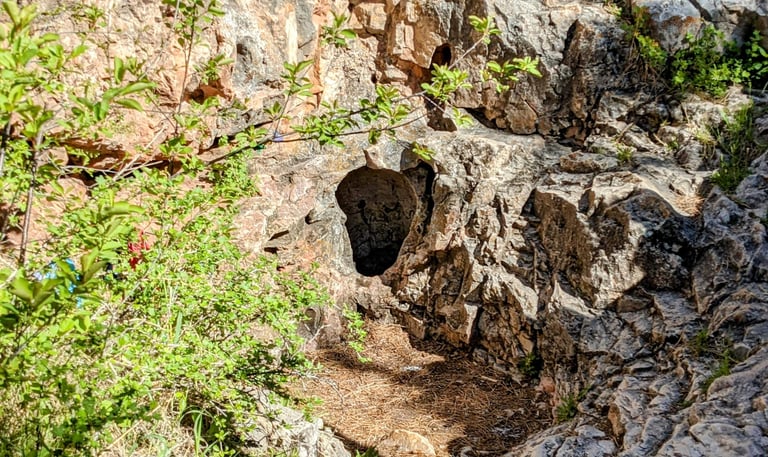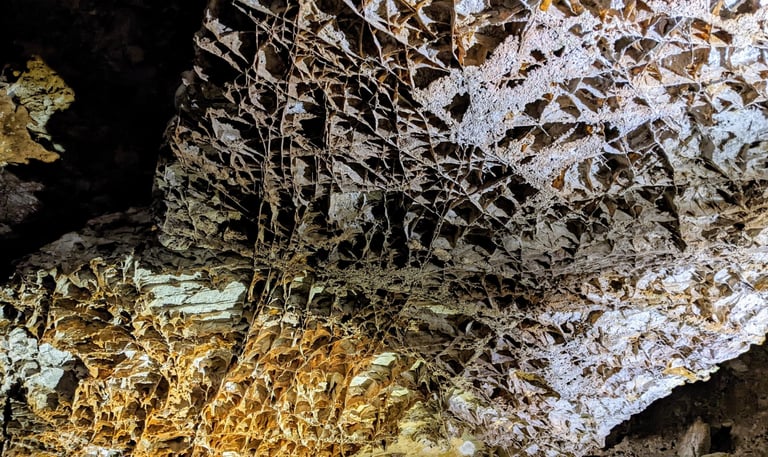Cave Week Day 3: Wind Cave - The Breathing Maze Beneath the Prarie
This isn’t your average cave—it breathes. Wind Cave is a dense, multi-layered pressure labyrinth beneath South Dakota’s prairies, packed with rare boxwork formations and 160+ miles of twisted, stacked passages. It holds cultural, biological, and geological importance—and it's still hiding secrets. Respect the pressure. The cave exhales.
CAVE WEEKFERAL SCIENCEWIND CAVECAVE & KARST
6/3/20253 min read
Some caves whisper. Wind Cave growls.
Hidden beneath the Black Hills of South Dakota, this underground beast doesn’t just sit quietly in the dark—it inhales, exhales, and dares you to try and understand it. Welcome to Wind Cave National Park—a place where barometric pressure plays games, the walls are laced with calcite blades, and claustrophobia is part of the experience.
This cave doesn’t stretch the farthest. It doesn’t go the deepest. But Wind Cave is dense, weird, and alive. It’s like Mother Nature tried to build a haunted cathedral inside a pressure cooker and filled it with invisible microbes and ancient legends.
🌬️ Why Is It Called Wind Cave?
Because it breathes—literally. When explorers first found a tiny hole in the ground violently expelling air, they thought it was possessed. Turns out, it’s science: when the cave’s internal air pressure and the outside world fall out of sync, Wind Cave reacts—sometimes with enough force to rip hats off your head or pull air into the void like it’s inhaling souls. If that doesn’t qualify it as feral, we don’t know what does.
📍 Where It Lurks
Wind Cave is tucked into the southern Black Hills of South Dakota, just outside the town of Custer. Above ground, the park is home to sweeping prairies, bison herds, and ponderosa forests. Below ground? It's another story entirely: more than 160 miles of known passageways crammed into a relatively small area of rock—making it the most compactly complex cave system on Earth. If Mammoth Cave is a multi-lane highway, Wind Cave is a twisted crawlspace packed with biological secrets and razor-edged minerals.
🪨 What Makes Wind Cave a Freak of Nature?
🔹 Boxwork. So Much Boxwork. Wind Cave holds 95% of all known boxwork formations on Earth. Picture delicate, paper-thin blades of calcite crisscrossing across ceilings and walls like something from a fever dream. It's a natural fractal forged from geological pressure and indifference to your comfort. It’s rare. It’s beautiful. It’s sharp. And it’s everywhere.
🔹 Layered Chaos. Wind Cave doesn’t flow in one direction—it’s stacked. Passageways coil and twist through multiple levels, like a multiverse of stone all crammed into one snarled ecosystem. This isn’t a casual stroll. It’s vertical. It’s confusing. It’s alive.
🔹 It’s Still Hiding Secrets. 160+ miles mapped—and that’s just the accessible part. Cavers estimate they’ve only scratched the surface. What’s down there? No one knows. Air still flows through unknown voids. The map remains incomplete. And the cave isn’t helping.
🌿 Above vs Below: Two Worlds, One Breath
Above ground, Wind Cave National Park protects over 33,000 acres of prairie—the most intact mixed-grass prairie left in the U.S. Below, the cave connects to complex hydrological systems and unseen ecosystems.
And if you think that’s cool, wait until you realize:
The Lakota people recognize Wind Cave as a sacred place of emergence—a site of spiritual origin, rebirth, and ancestral power.
The cave was made a national park in 1903, specifically to protect the underground—not just the land above it.
The cave and prairie form a singular living system, where what happens below shapes the life above.
🔦 Visiting the Beast
Wind Cave is protected. You can’t just wander in—you have to go with a ranger, and for good reason. These tours aren’t window-shopping geology. They’re immersive, tight-squeezing, light-flickering subterranean therapy sessions.
Options include:
The Natural Entrance Tour: Historic, boxwork-rich, and windy.
Fairgrounds Tour: More intense. More stairs. Less sunlight.
Candlelight Tour: For fans of shadows, spookiness, and poor decisions.
Wild Cave Tour: Helmet, kneepads, crawling. You versus the rock. Feral edition.
🧬 Why Wind Cave Matters to CHAOS
Wind Cave is the kind of cave that rewires your brain. It's a living example of pressure dynamics, microbial evolution, and geological architecture so extreme it looks impossible.
At CHAOS Lab, this is exactly the kind of environment we study:
Microbial ecosystems pushing survival to the limit
Air exchange and pressure mechanics that mess with the atmosphere
Ancient cultural intersections with modern science
Hidden biomes with potential for bioprospecting and medicine
Geologic features that defy symmetry, logic, and sometimes physics
Wind Cave doesn’t just challenge explorers. It challenges assumptions—and that’s what science is about.
💭 Final Thought: Listen to the Air
Wind Cave doesn’t roar. It doesn’t flash its size. But if you listen—really listen—it breathes. It shifts. It reminds us that beneath every quiet patch of Earth, something vast and mysterious might be waiting. Unmapped. Unnamed. Unapologetically strange.
🎟️ Book your descent: https://www.nps.gov/wica
⚠️ Be humble. The cave doesn’t care how smart you are.
🌬️ It was here first. It will outlast us all.




Wind Cave: Where the Earth breathes, the walls bite, and the map is never finished.
